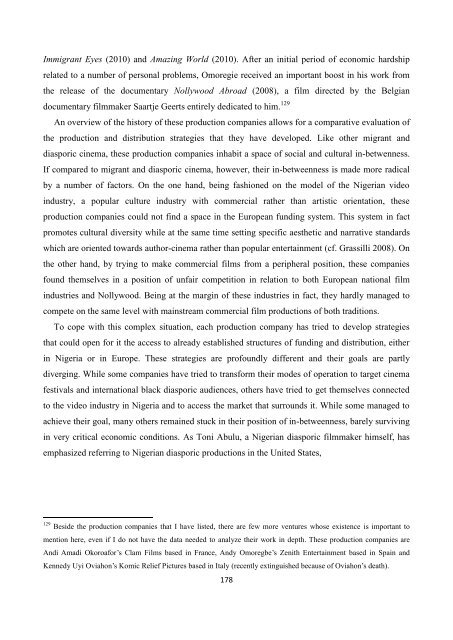Create successful ePaper yourself
Turn your PDF publications into a flip-book with our unique Google optimized e-Paper software.
Immigrant Eyes (2010) and Amazing World (2010). After an initial period of economic hardshiprelated to a number of personal problems, Omoregie received an important boost in his work fromthe release of the documentary Nollywood Abroad (2008), a film directed by the Belgiandocumentary filmmaker Saartje Geerts entirely dedicated to him. 129An overview of the history of these production companies allows for a comparative evaluation ofthe production and distribution strategies that they have developed. Like other migrant anddiasporic cinema, these production companies inhabit a space of social and cultural in-betwenness.If compared to migrant and diasporic cinema, however, their in-betweenness is made more radicalby a number of factors. On the one hand, being fashioned on the model of the Nigerian videoindustry, a popular culture industry with commercial rather than artistic orientation, theseproduction companies could not find a space in the European funding system. This system in factpromotes cultural diversity while at the same time setting specific aesthetic and narrative standardswhich are oriented towards author-cinema rather than popular entertainment (cf. Grassilli 2008). Onthe other hand, by trying to make commercial films from a peripheral position, these companiesfound themselves in a position of unfair competition in relation to both European national filmindustries and Nollywood. Being at the margin of these industries in fact, they hardly managed tocompete on the same level with mainstream commercial film productions of both traditions.To cope with this complex situation, each production company has tried to develop strategiesthat could open for it the access to already established structures of funding and distribution, eitherin Nigeria or in Europe. These strategies are profoundly different and their goals are partlydiverging. While some companies have tried to transform their modes of operation to target cinemafestivals and international black diasporic audiences, others have tried to get themselves connectedto the video industry in Nigeria and to access the market that surrounds it. While some managed toachieve their goal, many others remained stuck in their position of in-betweenness, barely survivingin very critical economic conditions. As Toni Abulu, a Nigerian diasporic filmmaker himself, hasemphasized referring to Nigerian diasporic productions in the United States,129 Beside the production companies that I have listed, there are few more ventures whose existence is important tomention here, even if I do not have the data needed to analyze their work in depth. These production companies areAndi Amadi Okoroafor’s Clam Films based in France, Andy Omoregbe’s Zenith Entertainment based in Spain andKennedy Uyi Oviahon’s Komic Relief Pictures based in Italy (recently extinguished because of Oviahon’s death).178
















